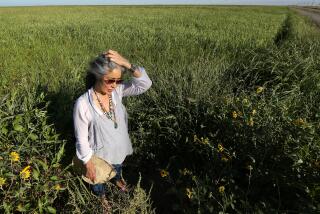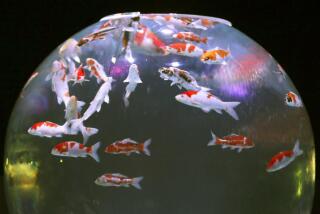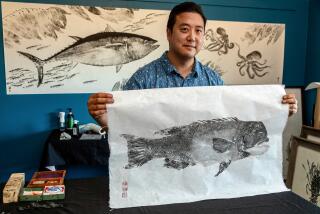Tale of Business Success Is More Than a Fish Story
- Share via
Nearly 40 years ago, when Tatsue Nakamaru bought her first pair of Japanese fish--two gold koi--she figured they would be nothing more than a family hobby.
But soon her husband, Mitsuru Nakamaru, began expanding the family pond. Then he started making trips to Japan, looking for prize specimens. Then he turned the family’s 38-foot swimming pool into a koi paradise.
“Pretty soon our whole back yard was for koi,” she said laughingly.
Mitsuru Nakamaru fell for koi hook, line and pocketbook. Today his family-run business, Asahi Fancy Koi in the Harbor Gateway area, is considered the oldest and possibly the largest koi enterprise in California. Its ponds and holding tanks, set among shady gardens and miniature waterfalls, hold hundreds of the koi--from $5 and $10 pond varieties to top-grade show fish that sell for $10,000 to $15,000 apiece.
Breeding Farm
At the family’s 40-acre breeding farm near the Salton Sea, three large lakes hold a “couple hundred thousand” more.
“We ship to New York, to Florida . . . two or three shipments a month,” said son Henry Nakamaru, 37, who handles sales and deliveries. “When we first came here in 1969 our most expensive fish sold for about $25. People said we were not going to last very long selling fish like that. But now those same fish are selling for $1,000 to $1,500” each.
At 65, Mitsuru Nakamaru, the former owner of a Hawaii-based vending machine company, is now regarded as one of the deans of American koi breeding, carrying on an art that has survived for centuries, said Jim Lewis, editor of Koi U.S.A., a trade publication.
Nakamaru retired from show competition 16 years ago as the only American ever to win top prize in the prestigious All-Japan Koi Show, held each January in Tokyo. He and Takemi Adachi, who owns California Koi Farms in Fallbrook, are the two largest sellers of koi in California and the two men most responsible for bringing top-quality koi to the United States, Lewis said.
‘Devoted His Life’
“He’s a legend in his own time--a worldwide figure in koi,” Lewis said of Nakamaru. “He’s devoted his life to it.”
Koi, a species of carp, are revered among collectors for their beauty and longevity. The brightly colored fish, introduced by Genghis Khan to the Orient in the 13th Century, look much like oversized goldfish, growing to lengths of up to four feet.
The name koi means “living jewel”--and, indeed, koi have sold for as much as $100,000 apiece in Japan, where they are considered pound-for-pound one of the most valuable animals in the world. Regarded as symbols of luck in the Japanese culture, koi have been known to live for a century or more.
One fish in Japan, which spent its final years in a university water tank, was found to have lived over 200 years, said Richard Burch, president of the Southern California Koi Club.
Counted Rings on Scale
“The age was documented by putting one of the (fish) scales under a . . . microscope and reading the rings on the scale, as you would read them on a tree,” Burch said.
Nakamaru, a stocky, soft-spoken Rancho Palos Verdes resident, has made it his goal to help popularize koi collecting in America. His wood-trimmed shop, located on 190th Street just east of Normandie Avenue, remains one of the best-known koi outlets in California, Lewis said. Others are Gardena Koi, owned by South Bay koi breeder Larry Ng, Adachi’s farm in Fallbrook, near San Diego, and additional farms in Newberry Springs, Fresno and Sacramento.
“We have (koi) that are becoming top fish just from his breeding,” said Millie Allison, a Beverly Hills resident whose collection is considered by club members to be among the finest in the world. “He’s a very outstanding breeder. He only uses top blood lines when he breeds, and that’s why they’re so good.”
Like precious gems, koi are judged for their size, shape and color. Nakamaru’s daughter, Carol, 36, said there are about 40 different Japanese names to describe the solid colors and patterns found in koi.
Red-and-white koi, for example, are called kohaku; red-and-white fish with black spots are called aigoromo; black koi with red markings are hi utsuri. Breeders are constantly striving to achieve deeper colors and more distinctive patterns.
Each Pattern Unique
“Usually the ones with patterns are more valuable because no two are alike,” Carol Nakamaru said. “With the solid colors, you may have two or three that look the same.” Which patterns are best? Usually it’s a matter of personal taste. “They have to be pleasing to the eye, like a painting,” she said.
But breeding is only a part of the effort, according to Nakamaru. At least once or twice each year, he said, he travels to Japan to look for top-quality fish and to “keep up with the times in Japan . . . (to study) how to breed them, how to combat disease.”
Millie Allison remembered an occasion when her husband, Don, had his heart set on a particular koi he hoped to add to the family collection, which now numbers about 600 fish. Her husband carried a picture of the top show fish for more than a year, she said, until they finally were able to travel with Nakamaru to Japan.
There, thanks to Nakamaru’s easy entree into Japanese koi circles, they were able to meet the fish’s owner and to buy the koi--for an amount she refuses to reveal. In many cases, she said, top-quality fish attract so much attention that dealers will show them only to other recognized dealers.
“You can’t just go over to Japan and go to a dealer and see the good fish,” Allison said. “Most times they would hide the fish, not even show it.”
$15,000 Not Unusual
The Nakamarus refuse to disclose how much they earn or how much they have invested in the koi trade, except to say it is no longer unusual to sell individual fish for $10,000 or $15,000. Each year, Henry Nakamaru said, the family sells 500 or 600 show-quality fish and “at least a couple thousand” of the less-valuable pond koi.
On his regular trips to Japan, Mitsuru Nakamaru typically brings back about 100 top-quality koi, using a Japanese airline experienced at handling the fish. The cost of each trip runs “thousands of dollars, anyway,” Nakamaru said with a chuckle.
But family members said the rising prices--a few years ago, they sold a 28-inch, red-and-white koi for $25,000--are evidence that Americans are becoming increasingly sophisticated koi buyers. Koi kishi, or aficionados, now travel from as far away as Beverly Hills, West Los Angeles, the San Fernando Valley, San Diego and even northern California to find the right fish for shows and competitions, they said.
“When we first started, it was hard to educate the people about the koi,” Tatsue Nakamaru said. “Now more and more people know.”
Each March, about 100 collectors gather for the store’s own show, Carol Nakamaru said. Several additional competitions are held each year throughout Southern California, including a scheduled event Oct. 5 and 6 at the Ventura County Fair, she said.
Popularity Grows
In recent years, according to Lewis, koi collecting has become increasingly popular in such countries as Australia, Brazil and Canada, as well as in such states as California, Florida and Texas.
Lewis estimated that there now are about 1,000 koi ponds in California, mostly in private yards. Collectors can keep the fish small or induce them to grow by building large ponds and pumping high levels of oxygen into the water, he said. Many owners find them surprisingly affectionate and intelligent, he said. “The fish will follow you around the yard,” Lewis said. “You can pet them on the head and they’ll eat out of your hand. They become like family pets--and they never bite the mailman or bark or dig in the yard.”
Few collectors, however, can boast a more elaborate pond than at the Nakamaru home in Rancho Palos Verdes, where the family keeps about 1,000 koi--just for their own amusement.
“We don’t have any opening for the yard,” Tatsue Nakamaru said. “The minute you open the door, there’s the pond.”
More to Read
Inside the business of entertainment
The Wide Shot brings you news, analysis and insights on everything from streaming wars to production — and what it all means for the future.
You may occasionally receive promotional content from the Los Angeles Times.










